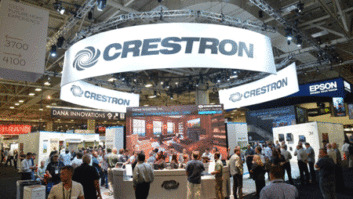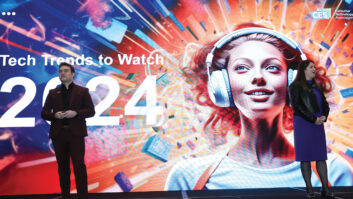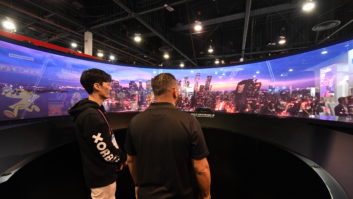CES has been over for about three weeks now, which is long enough to forget the crushing throngs of people crowding and pushing past me and the miles walking from one event to another, but recent enough where the show is still fresh in my mind, allowing the chance to pick through the noise and narrow in on things that will end up being important and meaningful to custom integrators.
Since the show, I’ve had several people ask me what I felt the big items were; people who weren’t able to attend and wondered what it was like to be in the heart of the glitz and glam as the world’s biggest electronics show spewed forth awesomeness all around you. Here’s what I’ve been telling them:
Full HD is Dead
A year ago at CES it seemed like Ultra High-Def (which I’m going to just call UHD or 4K from now on) was something manufacturers were kind of toying with. Sure, all the big manufacturers had sets, but there were just a few models, and they were drawing big crowds. UHD at CES that year was like taking a glimpse into the future, with 1080p still getting the lion’s share of attention. This year, however, 4K was everywhere. And it wasn’t even really a big deal. Attendees seemed to just take it for granted. “Yeah, it’s 4K now, OK.” It is now a ubiquitous display technology, and it is all that display manufacturers are focusing on. (Well, except that Sharp, Panasonic, Samsung and LG all showed 8K sets…) Non-4K, 1080p is such a dinosaur that I only saw a couple models at Sharp’s booth, and that was only because the company was touting their ability to produce massive — in this case 90-inch — Full HD panels. (Also, it seems a little oxymoronic to me that the term “Full HD” refers to 1080p; if it was truly “Full HD” wouldn’t it be the highest format of whatever HD was?) If you have any 1080p sets on your floor, move them out quickly and make room for 4K models because that’s what the Big Box stores are going to be doing.

Ultra High-Def/4K was the ubiquitous display technology at CES, and it is all that display manufacturers are focusing on. (Well, except that Sharp, Panasonic, Samsung and LG all showed 8K sets…)
Damn the Content, Full Speed Ahead!
With all the talk of 4K sets you might think that there would be lots of content announcements to go along. Well, that would be you using logic. In reality, the display manufacturers are content to crank up TV production whether there is any true-4K material to display or not. There were only two bits of 4K content news that I heard at the show, and those came from DISH and Panasonic. DISH announced the new “4K Joey” which will be the latest member of the Hopper troop. While information was thin — like the 4K Joey itself, which is startlingly thin! — the new STB will work with any 4K TV that is HDMI 2.0/HDCP 2.2-compliant and it will not only play 4K content, but it will be able to display two full 1080p programs on-screen simultaneously, side-by-side, which could be a pretty awesome feature for sports fans. While there were no content announcements yet, I heard a DISH spokesperson compare 4K content to the rollout of 1080p; “first it was a trickle, then it was a waterfall.” 4K Joey is slated for a Q2 release. The big news from Panasonic on the content front was a prototype 4K Blu-ray player. Information on this player was scarce, but we do know that it will support 3840×2160/60p at 10-bit, as well as High Dynamic Range and a bit-rate of 100Mbps. Looking at this player, and thinking of a new 4K Blu-ray disc, all I could hear was George Lucas’ voice in my head saying, “Isn’t it time you bought Star Wars….again?”
HDCP 2.2 – The Missing Link
It’s all well and good that display manufacturers are ramping up production of UHD TVs, but one of the new integration specters looming on the horizon is our good, ol’ friend HDCP. There is a new version of this copy protection — called 2.2 — that will be required for displaying UHD content, and if any part of the signal chain is not HDCP 2.2 compliant then there will be no 4K picture. Adding to the confusion is that products can be HDMI 2.0 certified but not HDCP 2.2. Ugh! Unfortunately, AV receiver manufacturers seem to be taking the slow boat to HDCP 2.2-compliantsville, and the vast majority of models now available do not support this necessary component of UHDTV. While not an issue today — you know, cause of the lack of 4K sources and all — it will inevitably cause problems down the road when your client wants to connect their new 4K Joey or 4K Blu-ray player to the new 4K TV that you sold them and they get the dreaded Black Screen of Nothingness.

Adding to the confusion about UHD TVs is that products can be HDMI 2.0 certified but not HDCP 2.2.
The Video Quality Winner is…
In truth, all of the 4K sets that I saw looked amazing. Of course, the higher resolution has little to do with the great picture — although the extra pixels certainly don’t hurt when you are staring at 60-inch screens from a foot or so away — and the beauty of UHD’s picture is far more due to features like High Dynamic Range and a wider color gamut, features that are far more readily apparent to even casual viewers. Whichever brand of displays your company supports — Sony, Samsung, Panasonic, LG, Sharp — rest assured that the image quality is going to be terrific.
Cosmetically, Sony’s micro-thin X900C series is very impressive. The sets are like four stacked credit cards at their thinnest point, and looks like it could double as a razor when you Dollar Shave Club shipment runs out. These sets will make for a very eye-catching demo on a display floor.
As great as all of the Quantum Dot — or nano-crystal (if you’re Samsung) or ColorPrime Nano Spectrum (if you’re LG) — sets looked, and they did look terrific with rich blacks and stunning color detail, they all fell short of the gorgeous image quality of OLED in my opinion. There is a quality to the OLED sets that is just notches above the other displays, similar, in a way, to how Pioneer Elite Kuro sets looked at their peak compared with LCD designs. LG is definitely the OLED leader, with seven new models coming this year ranging from 55 to 77 inches in size. There was no word on pricing, but if you have a high-end customer that is looking for the best TV money can buy, you should be investigating LG’s OLED offerings. And while I am still not a big fan of 3D, I have to give LG props as the OLED 4K 3D demo delivered what might be the very best 3D experience I’ve ever seen.

LG demonstrated the different between OLED and LED screens. Photo by Michael Heiss.
The Connected IoT World
While the custom installation industry has enjoyed a relatively long period of non-competition from mass-market products, this seems to be changing with the massive influx of smart, connected, cloud-based technologies on display at CES. Nearly anything you can imagine — coffee makers, mattresses, sniper rifles, batteries, power outlets, toothbrushes — was internet connected and coming to market. We have already seen the “power” of the Nest thermostat, giving homeowner’s the ability to do some automation on their own, and the day of the screw-in light bulb with intelligence built-in creating an instant housewide lighting system is imminently upon us. For the time being, many of these connected products are going to be islands unto themselves, requiring their own apps and not interacting with other systems or devices. The ability to integrate, control and simplify an entire home in one place via automation systems like Crestron, Control4, Savant, ELAN, URC, RTI, or whatever, with a single “Home,” “Away,” or “Entertain” button able to command the entire home, will remain our advantage, and is certainly something we should continue touting and leveraging to our advantage.
John Sciacca is principal of Custom Theater and Audio in Myrtle Beach, SC.






